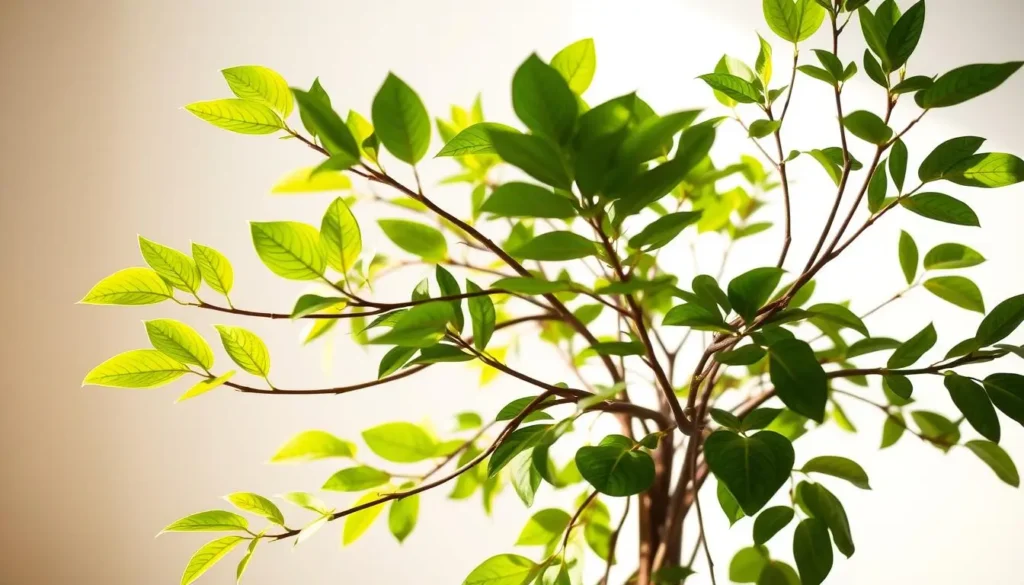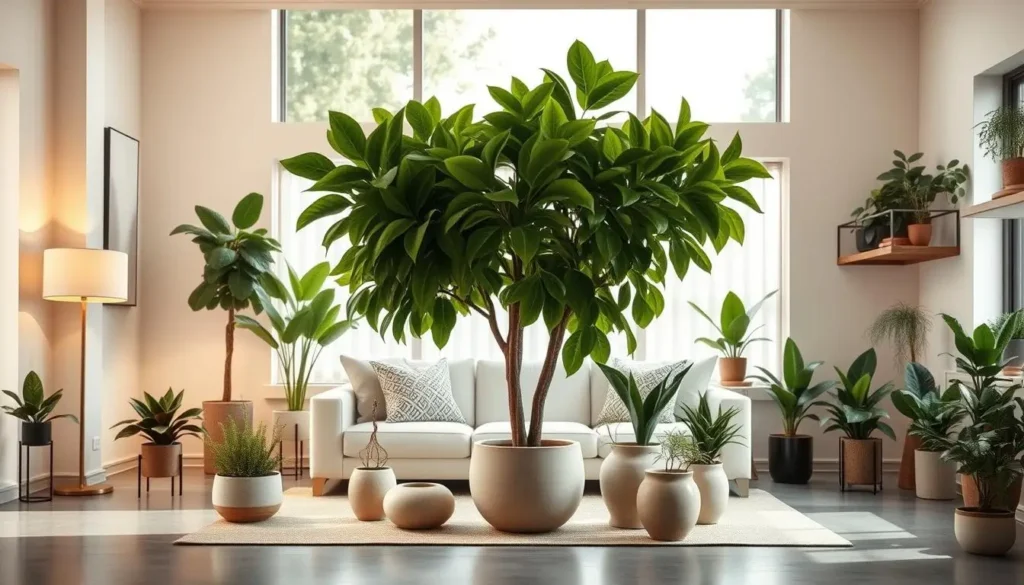Ficus Indoor Plant: The Ultimate Guide to Thriving Beauty.
Imagine bringing home a lush ficus indoor plant, hoping to brighten your space. But weeks later, its leaves droop, and you’re left wondering what went wrong.
Many of us have felt that mix of hope and worry when caring for these plants.
Ficus plants are more than just houseplants; they’re living art. Their glossy leaves and sculptural shapes can transform a room.
But to succeed, you need to understand their needs. This guide will help you turn your initial interest into a thriving, vibrant display of nature’s beauty in your home.
Key Takeaways
- Learn how to choose the perfect ficus indoor plant for your lifestyle and space.
- Master caring for ficus plants through light, water, and humidity tips tailored to their natural habits.
- Discover why these plants improve air quality and mental well-being in your home.
- Understand common challenges like leaf drop and how to avoid them.
- Get actionable advice to keep your ficus healthy for years, from pruning to repotting.
Introduction to the Ficus Indoor Plant Family
Ficus plants are fascinating, with over 850 species in the mulberry family. They love different environments, making them great for indoor spaces. Let’s dive into their history, why they’re popular, and how their origins guide their care.

“Ficus plants have journeyed from ancient temple gardens to modern living rooms, carrying centuries of resilience.” – International Plant Explorers Society
The History and Origins of Ficus Plants
These plants come from Southeast Asia and the Mediterranean. They were loved in ancient times. Egyptians drew fig trees, and Romans saw them as symbols of plenty.
They spread worldwide through trade, becoming a favorite indoor plant by the 19th century.
Why Ficus Plants Have Become Popular Houseplants
- Low Maintenance: They can handle some neglect and add green beauty.
- Architectural Form: Their upright shape fits well with modern decor.
- Air-Purifying: NASA found they clean indoor air well.
Natural Habitats and What They Tell Us About Care
| Habitat Feature | Natural Environment | Indoor Care Tips |
|---|---|---|
| Light | Tropical canopies with dappled sunlight | Place near east-facing windows |
| Soil | Well-drained forest floors | Use loose, porous soil mixes |
| Humidity | Subtropical humidity levels | Mist leaves weekly in dry climates |
Knowing their natural habitats helps you care for them better. These basics will prepare you for successful care in the next sections.
Popular Ficus Varieties for Your Indoor Space
Choosing the right popular indoor plant varieties means knowing which Ficus species do well at home. Three top picks—ficus elastica, ficus lyrata, and others—each bring something special to your space. They fit different needs and skill levels.

| Variety | Key Features | Care Tips |
|---|---|---|
| Ficus elastica (Rubber Plant) | Thick, dark green leaves; tolerant of low light | Water every 1-2 weeks; avoid overwatering |
| Ficus lyrata (Fiddle Leaf Fig) | Large, violin-shaped leaves; dramatic presence | Bright indirect light; wipe leaves monthly |
| Ficus benjamina (Weeping Fig) | Graceful arching branches; sensitive to changes | Consistent watering; avoid moving abruptly |
| Ficus microcarpa (Ginseng Ficus) | Knotted trunk; compact growth | Allow soil to dry between waterings |
| Ficus pumila (Creeping Fig) | Trailing vines; great for vertical spaces | High humidity; train on structures |
Starters often pick ficus elastica because it’s easy to care for. The ficus lyrata needs more light but offers striking leaves. Think about your home’s light and space before choosing. Each plant’s needs affect its success.
Use this guide with the right soil and humidity tips to keep your plants happy.
The Remarkable Benefits of Growing Ficus Plants Indoors
Ficus plants do more than just look good—they improve your health and style. They are best indoor plant for air quality, cleaning the air you breathe. Plus, they add a natural touch to any room.
Ficus as One of the Best Indoor Plants for Air Quality
NASA research confirms that ficus plants efficiently remove pollutants like formaldehyde and benzene from indoor air.
These plants are better than many decorative indoor plants at cleaning the air. They have wide leaves that soak up bad stuff and release oxygen. This makes the air healthier to breathe.
Psychological Benefits of Indoor Greenery
- Reduces stress hormones by up to 12% (University of Agriculture, Norway)
- Boosts focus in home offices and living areas
- Enhances mood through biophilic design principles
Decorative Value in Interior Design

Here are some design tips:
- Use tall varieties like the weeping fig as bold focal points
- Pair small-leaf varieties with neutral decor for contrast
- Position trailing varieties on shelves to create vertical green walls
These plants are not just good for the air—they also define spaces. They are key for creating mindful living areas. They serve as both best indoor plant for air quality and decorative indoor plants.
Essential Light Requirements for a Thriving Ficus
Light is very important for caring for ficus plants. Most ficus plants need bright, indirect light to thrive. But, each type has its own needs. For example, tips for growing indoor ficus like the Fiddle Leaf Fig need more light than the Cast Iron Plant. Here’s how to get it right:
- Check light levels weekly. Place your plant near an east- or west-facing window for best results.
- Avoid direct sun exposure, which can scorch leaves. A sheer curtain helps filter harsh rays.
- Use a light meter app (like LightMeter Pro) to ensure 100–200 foot-candles of light.
Adjust placement seasonally. In winter, move plants closer to windows as daylight weakens. Leggy growth or yellow leaves signal insufficient light. Consider LED grow lights like Fluval Plant & Growth Light if natural light is limited.
| Variety | Light Preference | Signs of Stress |
|---|---|---|
| Fiddle Leaf Fig | Bright indirect light | Smaller new leaves |
| Weeping Fig | Moderate indirect light | Leaf drop |
| Rubber Plant | Medium to low light | Slow growth |
Avoid sudden light changes. Gradually acclimate your plant to new spots over 1–2 weeks. Ficus recover poorly from shock caused by abrupt moves.
“Light consistency is critical for ficus,” says Dr. Linda Chalker-Scott of Washington State University. “Steady conditions prevent stress-related leaf loss.”
Test light quality with the shadow test: hold your hand above the plant. A sharp shadow means bright light; a faint one means low. Adjust placement based on results. Proper lighting prevents common issues and keeps foliage lush year-round.
Water and Humidity: Finding the Perfect Balance
Learning the indoor plant care guide basics starts with knowing how to water and humidify your ficus. Caring for ficus plants means being flexible. Adjusting to seasons and plant signals keeps roots healthy and leaves lush.
Seasonal Watering Adjustments
Here’s how to adjust watering throughout the year:
- In spring and summer, water when the top 1-2 inches of soil feels dry. Growth spikes mean more frequent checks.
- Cut back to monthly watering in winter. Overwatering in dormancy causes root rot, a common caring for ficus plants mistake.
- Use a moisture meter if indoor heating or AC dries air—adjust based on soil dryness, not a fixed schedule.
Humidity Needs for Different Ficus Varieties
Match humidity to your plant’s origin:
| Ficus Variety | Optimal Humidity | Best Methods |
|---|---|---|
| Fiddle-Leaf Fig | 40–60% | Pebble tray + weekly misting |
| Weeping Fig | 50–70% | Group with other plants to boost moisture |
| Rubber Plant | 30–50% | Occasional misting, avoid over-humidifying |
Warning Signs of Improper Watering
- Overwatering: Yellow leaves at the base, soggy soil, or a musty smell signal root rot.
- Underwatering: Crispy leaf edges and persistent wilting mean soil has dried too long.
Adjust care by testing soil with your finger before watering. Healthy roots = healthy growth!
Soil, Fertilization, and Repotting Guidelines
Healthy soil is key for low maintenance indoor plants like ficus. Pick a mix that drains well to avoid root rot. A mix of peat moss, perlite, and compost works great. You can also use Miracle-Gro Indoor Potting Mix or Espoma Organic Potting Mix.
Feeding schedules matter:
- Fertilize spring to fall with a balanced 10-10-10 liquid fertilizer every 4-6 weeks.
- Cut back to monthly feedings in winter when growth slows.
- Use slow-release pellets for low maintenance indoor plants that prefer infrequent care.
Repotting is important every 2-3 years when roots outgrow the pot. Look for roots poking out or slowed growth. Here’s how to repot:
| Step | Action |
|---|---|
| 1 | Select a pot 2 inches wider in diameter than current container |
| 2 | Loosen roots gently before placing in fresh soil mix |
| 3 | Water thoroughly after repotting to settle soil |
Avoid overpotting—never use a pot larger than 2 inches wider. Ficus roots need space but thrive in snug conditions.
Mist foliage lightly after repotting to reduce stress. These tips for growing indoor ficus ensure they stay vigorous while staying easy to care for. Proper soil and timing keep them lush without demanding constant attention, fitting their reputation as low-maintenance beauties.
Troubleshooting Common Ficus Plant Problems
Even with proper caring for ficus plants, issues can arise. This indoor plant care guide helps solve common problems.
Leaf Drop: Causes and Solutions
Yellowing leaves or sudden drops often signal stress. Overwatering, cold drafts, or abrupt light changes are typical culprits. Solutions:
- Check soil moisture—water only when top 2 inches are dry.
- Move plants away from vents or doors to avoid drafts.
- Gradually acclimate plants to new light positions to prevent shock.
Pests That Target Ficus Plants
Inspect plants weekly for these invaders:
| Pest | Signs | Treatment |
|---|---|---|
| Spider Mites | Fine webbing, stippled leaves | Rinse leaves with water or apply neem oil. |
| Scale Insects | Bumpy bumps on stems, sticky residue | Wipe with alcohol-soaked cotton swabs. |
| Mealybugs | White cotton-like clusters | Isolate the plant and use insecticidal soap. |
Diseases and How to Treat Them
Fungal infections like root rot or leaf spots require quick action. Remove affected leaves and adjust care:
- Trim rotted roots and repot in fresh soil.
- Use a fungicide for severe fungal issues.
- Ensure good airflow to prevent recurrence.
Reviving a Struggling Ficus
If your plant looks weak:
“Patience is key—most plants recover with consistent care adjustments.”
- Assess roots for rot; prune damaged parts.
- Adjust watering and humidity to match plant needs.
- Provide filtered light and monitor progress weekly.
Follow these steps in your indoor plant care guide to keep your plants healthy.
Pruning and Shaping Your Ficus for Optimal Growth
Pruning turns your ficus into a living work of art. Learning the right cuts keeps your plant healthy and eye-catching. Every cut shapes the foliage and the plant’s future.
Let’s see how to make your tips for growing indoor ficus thrive and look unique.
Basic Pruning Techniques
Begin with clean, sharp shears and wear rubber gloves for sap. Cut just above leaf nodes to encourage new growth. Remove dead or crossing branches first to help healthy growth.
Always disinfect tools between cuts to stop disease spread.
- Use bypass pruners for clean cuts
- Wipe blades with rubbing alcohol between cuts
- Target water shoots to maintain symmetry
Creating a Statement Plant Through Strategic Shaping
“A well-pruned ficus isn’t just cared for—it’s conversed with.”
Turn your plant into a sculptural centerpiece. Pinch young shoots to promote bushiness. Train stems into braids or multi-trunk forms.
Variegated varieties like Ficus lyrata (fiddle-leaf fig) look great in topiary styles. Try different shapes to fit your space’s look.
Timing Your Pruning Sessions
Do major pruning in spring when sap flows well. Light trims can be done anytime to keep shape. Avoid late fall cuts as they slow recovery.
Follow this guide:
- Spring: Trim up to ⅓ of growth for renewal
- Summer: Light tip pruning to control size
- Winter: Avoid heavy cuts; focus on deadwood removal
Propagation Methods to Expand Your Ficus Collection
Make one ficus indoor plant into many with propagation. These methods help you grow new plants easily. They’re great for those who love low maintenance indoor plants. Here’s how to get started:
- Stem Cuttings: Cut a 4-6″ stem, remove leaves at the bottom, and plant in water or soil. Roots should appear in 2-4 weeks.
- Air Layering: Wrap a cut stem with moss and plastic. Wait 4-8 weeks for roots to grow before transplanting.
- Division: Separate the roots of varieties like Benjamin Ficus when you repot them.
| Method | Best Varieties | Time to Root | Difficulty |
|---|---|---|---|
| Stem Cuttings (Water) | Weeping Fig, Fiddle-Leaf Fig | 2-4 weeks | Easy |
| Air Layering | Rubber Plant, Banana Leaf Ficus | 4-8 weeks | Moderate |
| Division | Cluster-forming types | 1-2 weeks | Easy |
Use sharp, clean tools and soil that drains well. Spring is the best time to start. Mist the cuttings to keep them moist. But don’t overwater to avoid root rot.
Sharing rooted cuttings with others creates connections while expanding your collection.
Here are some tips to solve common problems:
- Is it rotting? Clean your tools and let the soil dry between waterings.
- Are the roots slow? Try placing them in a warm spot (70-80°F) to speed up growth.
Propagation saves money and revives struggling plants. Each new plant tells a story, making your ficus indoor plant hobby a thriving network of green spaces.
Conclusion: Enjoying the Long-Term Beauty of Your Ficus Indoor Plant
Choosing a ficus indoor plant brings a piece of nature into your home. These plants clean the air and fit well in many spaces. They make any room look better and feel healthier.
By paying attention to light, water, and soil, you help your plant grow well. Regular pruning and repotting keep it healthy and beautiful. Even plants like the Fiddle Leaf Fig and Weeping Fig can do well with the right care.
But, you might face problems like pests or leaf drop. The solutions in this guide help you keep your plant happy. As you care for it, you’ll get better at spotting problems early. This makes your bond with the plant stronger.
Whether you’re starting with a new ficus or caring for one you already have, the benefits are clear. These plants bring lasting beauty and a sense of pride as they grow.
With patience and the tips from this guide, your ficus will be a beloved part of your home for years. They show that even low maintenance plants can be both tough and rewarding.
FAQ
What is the best indoor plant for air quality?
The ficus indoor plant is top-notch for air quality. Varieties like Ficus elastica and Ficus lyrata are great. They clean the air in your home.
How do I care for my ficus plants?
To care for ficus plants, make sure they get enough light and water. Ficus elastica and Ficus lyrata need bright, indirect light. Let the soil dry a bit before watering again.
Check the humidity, too, to keep them happy. This is more important in winter.
Can you provide tips for growing indoor ficus?
Sure! Here’s how to grow your ficus: – Put it in a spot with bright, indirect light. – Water when the soil feels dry. – Keep humidity between 40-60% for best growth. – Prune often to keep it bushy.
What are some popular indoor plant varieties of ficus?
Popular ficus varieties include Ficus elastica, Ficus lyrata, and Ficus benjamina. Each has its own look and care needs. They’re all favorites among plant lovers.
Is the ficus a low-maintenance indoor plant?
Yes, many ficus plants are easy to care for. They do well with the right light, water, and humidity. But, paying attention to their needs can make them even healthier.
How do I determine the right soil for my ficus?
Ficus plants like well-draining soil that holds moisture but doesn’t get too wet. A mix that’s slightly acidic and rich in organic matter is best. You can also make your own or buy a commercial mix.
What are the signs of overwatering in ficus plants?
Overwatering shows as yellow leaves, a soft root ball, and droopy plants. If you see these signs, water less and make sure the pot drains well.
How do I propagate a ficus plant?
Propagate ficus plants with stem cuttings. Take a healthy cutting and put it in water or soil. Make sure it’s in the right humidity and warmth for roots to grow. Spring or early summer is the best time to do this.
Want More Plant Tips? Follow Us!
🌿 YouTube: Watch detailed plant care tutorials.
📌 Pinterest: Discover stunning plant decor ideas.
🎥 TikTok: Get quick and fun plant hacks.
Join our plant-loving community today!”

